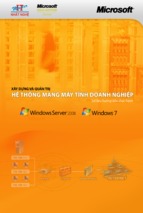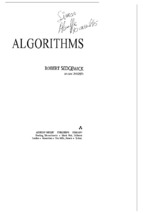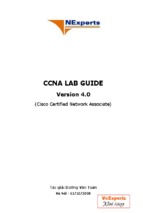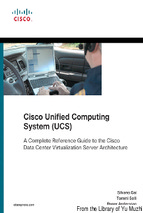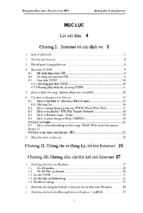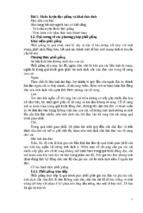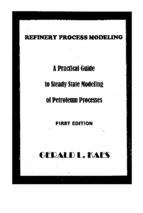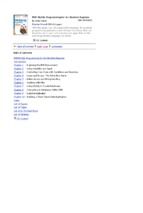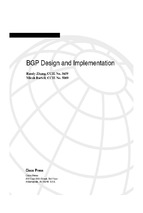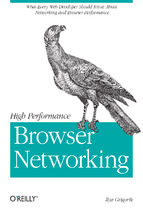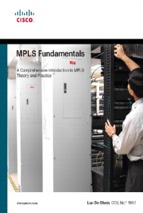High-Performance Browser
Networking
Ilya Grigorik
High-Performance Browser Networking
by Ilya Grigorik
Copyright © 2013 Ilya Grigorik. All rights reserved.
Printed in the United States of America.
Published by O’Reilly Media, Inc., 1005 Gravenstein Highway North, Sebastopol, CA 95472.
O’Reilly books may be purchased for educational, business, or sales promotional use. Online editions are
also available for most titles (http://my.safaribooksonline.com). For more information, contact our corporate/
institutional sales department: 800-998-9938 or
[email protected].
Editor: Courtney Nash
Production Editor: Melanie Yarbrough
Proofreader: Julie Van Keuren
Indexer: WordCo Indexing Services
September 2013:
Cover Designer: Randy Comer
Interior Designer: David Futato
Illustrator: Kara Ebrahim
First Edition
Revision History for the First Edition:
2013-09-09:
First release
See http://oreilly.com/catalog/errata.csp?isbn=9781449344764 for release details.
Nutshell Handbook, the Nutshell Handbook logo, and the O’Reilly logo are registered trademarks of O’Reilly
Media, Inc. High-Performance Browser Networking, the image of a Madagascar harrier, and related trade
dress are trademarks of O’Reilly Media, Inc.
Many of the designations used by manufacturers and sellers to distinguish their products are claimed as
trademarks. Where those designations appear in this book, and O’Reilly Media, Inc., was aware of a trade‐
mark claim, the designations have been printed in caps or initial caps.
While every precaution has been taken in the preparation of this book, the publisher and author assume no
responsibility for errors or omissions, or for damages resulting from the use of the information contained
herein.
ISBN: 978-1-449-34476-4
[LSI]
Table of Contents
Foreword. . . . . . . . . . . . . . . . . . . . . . . . . . . . . . . . . . . . . . . . . . . . . . . . . . . . . . . . . . . . . . . . . . . . . xi
Preface. . . . . . . . . . . . . . . . . . . . . . . . . . . . . . . . . . . . . . . . . . . . . . . . . . . . . . . . . . . . . . . . . . . . . . xiii
Part I.
Networking 101
1. Primer on Latency and Bandwidth. . . . . . . . . . . . . . . . . . . . . . . . . . . . . . . . . . . . . . . . . . . . . 3
Speed Is a Feature
The Many Components of Latency
Speed of Light and Propagation Latency
Last-Mile Latency
Bandwidth in Core Networks
Bandwidth at the Network Edge
Delivering Higher Bandwidth and Lower Latencies
3
4
6
8
9
10
11
2. Building Blocks of TCP. . . . . . . . . . . . . . . . . . . . . . . . . . . . . . . . . . . . . . . . . . . . . . . . . . . . . . . 13
Three-Way Handshake
Congestion Avoidance and Control
Flow Control
Slow-Start
Congestion Avoidance
Bandwidth-Delay Product
Head-of-Line Blocking
Optimizing for TCP
Tuning Server Configuration
Tuning Application Behavior
Performance Checklist
14
16
17
19
26
28
30
32
32
34
34
3. Building Blocks of UDP. . . . . . . . . . . . . . . . . . . . . . . . . . . . . . . . . . . . . . . . . . . . . . . . . . . . . . 35
Null Protocol Services
36
iii
UDP and Network Address Translators
Connection-State Timeouts
NAT Traversal
STUN, TURN, and ICE
Optimizing for UDP
38
39
40
41
44
4. Transport Layer Security (TLS). . . . . . . . . . . . . . . . . . . . . . . . . . . . . . . . . . . . . . . . . . . . . . . . 47
Encryption, Authentication, and Integrity
TLS Handshake
Application Layer Protocol Negotiation (ALPN)
Server Name Indication (SNI)
TLS Session Resumption
Session Identifiers
Session Tickets
Chain of Trust and Certificate Authorities
Certificate Revocation
Certificate Revocation List (CRL)
Online Certificate Status Protocol (OCSP)
TLS Record Protocol
Optimizing for TLS
Computational Costs
Early Termination
Session Caching and Stateless Resumption
TLS Record Size
TLS Compression
Certificate-Chain Length
OCSP Stapling
HTTP Strict Transport Security (HSTS)
Performance Checklist
Testing and Verification
Part II.
48
50
53
54
55
55
57
57
61
61
62
62
63
64
65
67
68
69
70
71
72
73
73
Performance of Wireless Networks
5. Introduction to Wireless Networks. . . . . . . . . . . . . . . . . . . . . . . . . . . . . . . . . . . . . . . . . . . . 79
Ubiquitous Connectivity
Types of Wireless Networks
Performance Fundamentals of Wireless Networks
Bandwidth
Signal Power
Modulation
iv |
Table of Contents
79
80
81
82
85
86
Measuring Real-World Wireless Performance
87
6. WiFi. . . . . . . . . . . . . . . . . . . . . . . . . . . . . . . . . . . . . . . . . . . . . . . . . . . . . . . . . . . . . . . . . . . . . . 89
From Ethernet to a Wireless LAN
WiFi Standards and Features
Measuring and Optimizing WiFi Performance
Packet Loss in WiFi Networks
Optimizing for WiFi Networks
Leverage Unmetered Bandwidth
Adapt to Variable Bandwidth
Adapt to Variable Latency
89
91
92
94
95
95
96
97
7. Mobile Networks. . . . . . . . . . . . . . . . . . . . . . . . . . . . . . . . . . . . . . . . . . . . . . . . . . . . . . . . . . . 99
Brief History of the G’s
First Data Services with 2G
3GPP and 3GPP2 Partnerships
Evolution of 3G Technologies
IMT-Advanced 4G Requirements
Long Term Evolution (LTE)
HSPA+ is Leading Worldwide 4G Adoption
Building for the Multigeneration Future
Device Features and Capabilities
User Equipment Category
Radio Resource Controller (RRC)
3G, 4G, and WiFi Power Requirements
LTE RRC State Machine
HSPA and HSPA+ (UMTS) RRC State Machine
EV-DO (CDMA) RRC State Machine
Inefficiency of Periodic Transfers
End-to-End Carrier Architecture
Radio Access Network (RAN)
Core Network (CN)
Backhaul Capacity and Latency
Packet Flow in a Mobile Network
Initiating a Request
Inbound Data Flow
Heterogeneous Networks (HetNets)
Real-World 3G, 4G, and WiFi Performance
99
100
101
103
105
106
107
109
111
111
113
115
116
119
120
121
123
123
125
128
129
129
132
133
135
8. Optimizing for Mobile Networks. . . . . . . . . . . . . . . . . . . . . . . . . . . . . . . . . . . . . . . . . . . . . 139
Preserve Battery Power
Eliminate Periodic and Inefficient Data Transfers
140
142
Table of Contents
|
v
Eliminate Unnecessary Application Keepalives
Anticipate Network Latency Overhead
Account for RRC State Transitions
Decouple User Interactions from Network Communication
Design for Variable Network Interface Availability
Burst Your Data and Return to Idle
Offload to WiFi Networks
Apply Protocol and Application Best Practices
Part III.
144
145
146
146
147
149
150
150
HTTP
9. Brief History of HTTP. . . . . . . . . . . . . . . . . . . . . . . . . . . . . . . . . . . . . . . . . . . . . . . . . . . . . . . 155
HTTP 0.9: The One-Line Protocol
HTTP 1.0: Rapid Growth and Informational RFC
HTTP 1.1: Internet Standard
HTTP 2.0: Improving Transport Performance
155
157
159
161
10. Primer on Web Performance. . . . . . . . . . . . . . . . . . . . . . . . . . . . . . . . . . . . . . . . . . . . . . . . 165
Hypertext, Web Pages, and Web Applications
Anatomy of a Modern Web Application
Speed, Performance, and Human Perception
Analyzing the Resource Waterfall
Performance Pillars: Computing, Rendering, Networking
More Bandwidth Doesn’t Matter (Much)
Latency as a Performance Bottleneck
Synthetic and Real-User Performance Measurement
Browser Optimization
166
168
170
171
176
176
177
179
183
11. HTTP 1.X. . . . . . . . . . . . . . . . . . . . . . . . . . . . . . . . . . . . . . . . . . . . . . . . . . . . . . . . . . . . . . . . . 187
Benefits of Keepalive Connections
HTTP Pipelining
Using Multiple TCP Connections
Domain Sharding
Measuring and Controlling Protocol Overhead
Concatenation and Spriting
Resource Inlining
189
192
196
198
200
201
204
12. HTTP 2.0. . . . . . . . . . . . . . . . . . . . . . . . . . . . . . . . . . . . . . . . . . . . . . . . . . . . . . . . . . . . . . . . . 207
History and Relationship to SPDY
The Road to HTTP 2.0
Design and Technical Goals
vi
|
Table of Contents
208
209
211
Binary Framing Layer
Streams, Messages, and Frames
Request and Response Multiplexing
Request Prioritization
One Connection Per Origin
Flow Control
Server Push
Header Compression
Efficient HTTP 2.0 Upgrade and Discovery
Brief Introduction to Binary Framing
Initiating a New Stream
Sending Application Data
Analyzing HTTP 2.0 Frame Data Flow
211
212
214
215
217
218
219
222
224
226
229
230
230
13. Optimizing Application Delivery. . . . . . . . . . . . . . . . . . . . . . . . . . . . . . . . . . . . . . . . . . . . . 233
Evergreen Performance Best Practices
Cache Resources on the Client
Compress Transferred Data
Eliminate Unnecessary Request Bytes
Parallelize Request and Response Processing
Optimizing for HTTP 1.x
Optimizing for HTTP 2.0
Removing 1.x Optimizations
Dual-Protocol Application Strategies
Translating 1.x to 2.0 and Back
Evaluating Server Quality and Performance
Speaking 2.0 with and without TLS
Load Balancers, Proxies, and Application Servers
Part IV.
235
236
237
238
239
241
241
242
244
245
247
247
248
Browser APIs and Protocols
14. Primer on Browser Networking. . . . . . . . . . . . . . . . . . . . . . . . . . . . . . . . . . . . . . . . . . . . . . 253
Connection Management and Optimization
Network Security and Sandboxing
Resource and Client State Caching
Application APIs and Protocols
254
256
257
258
15. XMLHttpRequest. . . . . . . . . . . . . . . . . . . . . . . . . . . . . . . . . . . . . . . . . . . . . . . . . . . . . . . . . . 261
Brief History of XHR
Cross-Origin Resource Sharing (CORS)
Downloading Data with XHR
262
263
266
Table of Contents
|
vii
Uploading Data with XHR
Monitoring Download and Upload Progress
Streaming Data with XHR
Real-Time Notifications and Delivery
Polling with XHR
Long-Polling with XHR
XHR Use Cases and Performance
268
269
271
273
274
276
278
16. Server-Sent Events (SSE). . . . . . . . . . . . . . . . . . . . . . . . . . . . . . . . . . . . . . . . . . . . . . . . . . . 279
EventSource API
Event Stream Protocol
SSE Use Cases and Performance
279
282
285
17. WebSocket. . . . . . . . . . . . . . . . . . . . . . . . . . . . . . . . . . . . . . . . . . . . . . . . . . . . . . . . . . . . . . . 287
WebSocket API
WS and WSS URL Schemes
Receiving Text and Binary Data
Sending Text and Binary Data
Subprotocol Negotiation
WebSocket Protocol
Binary Framing Layer
Protocol Extensions
HTTP Upgrade Negotiation
WebSocket Use Cases and Performance
Request and Response Streaming
Message Overhead
Data Efficiency and Compression
Custom Application Protocols
Deploying WebSocket Infrastructure
Performance Checklist
288
289
290
291
293
294
295
297
298
301
302
303
304
304
305
307
18. WebRTC. . . . . . . . . . . . . . . . . . . . . . . . . . . . . . . . . . . . . . . . . . . . . . . . . . . . . . . . . . . . . . . . . . 309
Standards and Development of WebRTC
Audio and Video Engines
Acquiring Audio and Video with getUserMedia
Real-Time Network Transports
Brief Introduction to RTCPeerConnection API
Establishing a Peer-to-Peer Connection
Signaling and Session Negotiation
Session Description Protocol (SDP)
Interactive Connectivity Establishment (ICE)
Incremental Provisioning (Trickle ICE)
viii
|
Table of Contents
310
311
312
315
317
319
320
322
325
328
Tracking ICE Gathering and Connectivity Status
Putting It All Together
Delivering Media and Application Data
Secure Communication with DTLS
Delivering Media with SRTP and SRTCP
Delivering application data with SCTP
DataChannel
Setup and Negotiation
Configuring Message Order and Reliability
Partially Reliable Delivery and Message Size
WebRTC Use Cases and Performance
Audio, Video, and Data Streaming
Multiparty Architectures
Infrastructure and Capacity Planning
Data Efficiency and Compression
Performance Checklist
329
332
337
337
340
344
348
350
353
355
356
356
358
359
361
361
Index. . . . . . . . . . . . . . . . . . . . . . . . . . . . . . . . . . . . . . . . . . . . . . . . . . . . . . . . . . . . . . . . . . . . . . . 363
Table of Contents
|
ix
Foreword
“Good developers know how things work. Great developers know why things work.”
We all resonate with this adage. We want to be that person who understands and can
explain the underpinning of the systems we depend on. And yet, if you’re a web devel‐
oper, you might be moving in the opposite direction.
Web development is becoming more and more specialized. What kind of web developer
are you? Frontend? Backend? Ops? Big data analytics? UI/UX? Storage? Video? Mes‐
saging? I would add “Performance Engineer” making that list of possible specializations
even longer.
It’s hard to balance studying the foundations of the technology stack with the need to
keep up with the latest innovations. And yet, if we don’t understand the foundation our
knowledge is hollow, shallow. Knowing how to use the topmost layers of the technology
stack isn’t enough. When the complex problems need to be solved, when the inexplicable
happens, the person who understands the foundation leads the way.
That’s why High Performance Browser Networking is an important book. If you’re a web
developer, the foundation of your technology stack is the Web and the myriad of net‐
working protocols it rides on: TCP, TLS, UDP, HTTP, and many others. Each of these
protocols has its own performance characteristics and optimizations, and to build high
performance applications you need to understand why the network behaves the way it
does.
Thank goodness you’ve found your way to this book. I wish I had this book when I
started web programming. I was able to move forward by listening to people who un‐
derstood the why of networking and read specifications to fill in the gaps. High Per‐
formance Browser Networking combines the expertise of a networking guru, Ilya Gri‐
gorik, with the necessary information from the many relevant specifications, all woven
together in one place.
xi
In High Performance Browser Networking, Ilya explains many whys of networking: Why
latency is the performance bottleneck. Why TCP isn’t always the best transport mech‐
anism and UDP might be your better choice. Why reusing connections is a critical
optimization. He then goes even further by providing specific actions for improving
networking performance. Want to reduce latency? Terminate sessions at a server closer
to the client. Want to increase connection reuse? Enable connection keep-alive. The
combination of understanding what to do and why it matters turns this knowledge into
action.
Ilya explains the foundation of networking and builds on that to introduce the latest
advances in protocols and browsers. The benefits of HTTP 2.0 are explained. XHR is
reviewed and its limitations motivate the introduction of Cross-Origin Resource Shar‐
ing. Server-Sent Events, WebSockets, and WebRTC are also covered, bringing us up to
date on the latest in browser networking.
Viewing the foundation and latest advances in networking from the perspective of per‐
formance is what ties the book together. Performance is the context that helps us see
the why of networking and translate that into how it affects our website and our users.
It transforms abstract specifications into tools that we can wield to optimize our websites
and create the best user experience possible. That’s important. That’s why you should
read this book.
—Steve Souders, Head Performance Engineer, Google, 2013
xii
|
Foreword
Preface
The web browser is the most widespread deployment platform available to developers
today: it is installed on every smartphone, tablet, laptop, desktop, and every other form
factor in between. In fact, current cumulative industry growth projections put us on
track for 20 billion connected devices by 2020—each with a browser, and at the very
least, WiFi or a cellular connection. The type of platform, manufacturer of the device,
or the version of the operating system do not matter—each and every device will have
a web browser, which by itself is getting more feature rich each day.
The browser of yesterday looks nothing like what we now have access to, thanks to all
the recent innovations: HTML and CSS form the presentation layer, JavaScript is the
new assembly language of the Web, and new HTML5 APIs are continuing to improve
and expose new platform capabilities for delivering engaging, high-performance ap‐
plications. There is simply no other technology, or platform, that has ever had the reach
or the distribution that is made available to us today when we develop for the browser.
And where there is big opportunity, innovation always follows.
In fact, there is no better example of the rapid progress and innovation than the net‐
working infrastructure within the browser. Historically, we have been restricted to sim‐
ple HTTP request-response interactions, and today we have mechanisms for efficient
streaming, bidirectional and real-time communication, ability to deliver custom appli‐
cation protocols, and even peer-to-peer videoconferencing and data delivery directly
between the peers—all with a few dozen lines of JavaScript.
The net result? Billions of connected devices, a swelling userbase for existing and new
online services, and high demand for high-performance web applications. Speed is a
feature, and in fact, for some applications it is the feature, and delivering a highperformance web application requires a solid foundation in how the browser and the
network interact. That is the subject of this book.
xiii
About This Book
Our goal is to cover what every developer should know about the network: what pro‐
tocols are being used and their inherent limitations, how to best optimize your appli‐
cations for the underlying network, and what networking capabilities the browser offers
and when to use them.
In the process, we will look at the internals of TCP, UDP, and TLS protocols, and how
to optimize our applications and infrastructure for each one. Then we’ll take a deep dive
into how the wireless and mobile networks work under the hood—this radio thing, it’s
very different—and discuss its implications for how we design and architect our appli‐
cations. Finally, we will dissect how the HTTP protocol works under the hood and
investigate the many new and exciting networking capabilities in the browser:
• Upcoming HTTP 2.0 improvements
• New XHR features and capabilities
• Data streaming with Server-Sent Events
• Bidirectional communication with WebSocket
• Peer-to-peer video and audio communication with WebRTC
• Peer-to-peer data exchange with DataChannel
Understanding how the individual bits are delivered, and the properties of each trans‐
port and protocol in use are essential knowledge for delivering high-performance ap‐
plications. After all, if our applications are blocked waiting on the network, then no
amount of rendering, JavaScript, or any other form of optimization will help! Our goal
is to eliminate this wait time by getting the best possible performance from the network.
High-Performance Browser Networking will be of interest to anyone interested in opti‐
mizing the delivery and performance of her applications, and more generally, curious
minds that are not satisfied with a simple checklist but want to know how the browser
and the underlying protocols actually work under the hood. The “how” and the “why”
go hand in hand: we’ll cover practical advice about configuration and architecture, and
we’ll also explore the trade-offs and the underlying reasons for each optimization.
Our primary focus is on the protocols and their properties with re‐
spect to applications running in the browser. However, all the discus‐
sions on TCP, UDP, TLS, HTTP, and just about every other protocol
we will cover are also directly applicable to native applications, re‐
gardless of the platform.
xiv
| Preface
Conventions Used in This Book
The following typographical conventions are used in this book:
Italic
Indicates new terms, URLs, email addresses, filenames, and file extensions.
Constant width
Used for program listings, as well as within paragraphs to refer to program elements
such as variable or function names, databases, data types, environment variables,
statements, and keywords.
Constant width bold
Shows commands or other text that should be typed literally by the user.
Constant width italic
Shows text that should be replaced with user-supplied values or by values deter‐
mined by context.
This icon signifies a tip, suggestion, or general note.
This icon indicates a warning or caution.
Safari® Books Online
Safari Books Online is an on-demand digital library that delivers
expert content in both book and video form from the world’s lead‐
ing authors in technology and business.
Technology professionals, software developers, web designers, and business and crea‐
tive professionals use Safari Books Online as their primary resource for research, prob‐
lem solving, learning, and certification training.
Safari Books Online offers a range of product mixes and pricing programs for organi‐
zations, government agencies, and individuals. Subscribers have access to thousands of
books, training videos, and prepublication manuscripts in one fully searchable database
from publishers like O’Reilly Media, Prentice Hall Professional, Addison-Wesley Pro‐
fessional, Microsoft Press, Sams, Que, Peachpit Press, Focal Press, Cisco Press, John
Wiley & Sons, Syngress, Morgan Kaufmann, IBM Redbooks, Packt, Adobe Press, FT
Press, Apress, Manning, New Riders, McGraw-Hill, Jones & Bartlett, Course
Preface
|
xv
Technology, and dozens more. For more information about Safari Books Online, please
visit us online.
How to Contact Us
Please address comments and questions concerning this book to the publisher:
O’Reilly Media, Inc.
1005 Gravenstein Highway North
Sebastopol, CA 95472
800-998-9938 (in the United States or Canada)
707-829-0515 (international or local)
707-829-0104 (fax)
We have a web page for this book, where we list errata, examples, and any additional
information. You can access this page at http://oreil.ly/high-performance-browser.
To comment or ask technical questions about this book, send email to bookques
[email protected].
For more information about our books, courses, conferences, and news, see our website
at http://www.oreilly.com.
Find us on Facebook: http://facebook.com/oreilly
Follow us on Twitter: http://twitter.com/oreillymedia
Watch us on YouTube: http://www.youtube.com/oreillymedia
xvi
|
Preface
PART I
Networking 101


